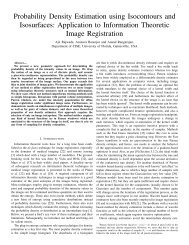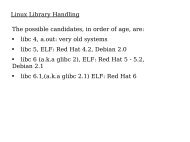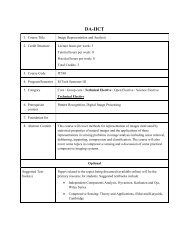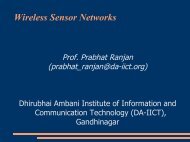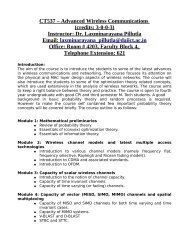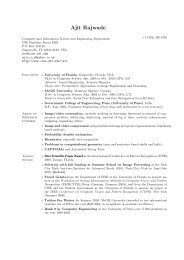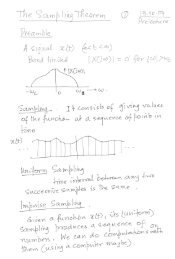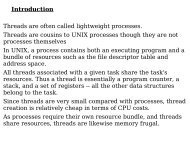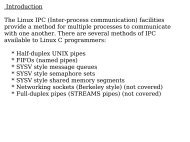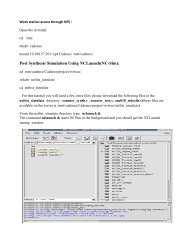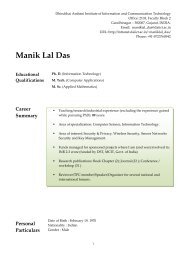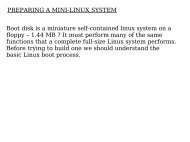Troop Movement Monitoring - DAIICT Intranet
Troop Movement Monitoring - DAIICT Intranet
Troop Movement Monitoring - DAIICT Intranet
You also want an ePaper? Increase the reach of your titles
YUMPU automatically turns print PDFs into web optimized ePapers that Google loves.
<strong>Troop</strong> <strong>Movement</strong><br />
<strong>Monitoring</strong><br />
By<br />
Maulik Bhagat<br />
200201078
Outline<br />
Introduction<br />
<strong>Troop</strong> <strong>Movement</strong> <strong>Monitoring</strong> System<br />
Concept<br />
Requirements<br />
Pros & Cons<br />
Existing Systems<br />
Unattended Ground Sensor System ( UGSS )<br />
Remote Battlefield Sensor System ( REMBASS ) & Improved- Improved<br />
REMBASS<br />
Smart Dust<br />
Conclusion
Introduction<br />
Wireless sensor network (WSN)<br />
An autonomous,<br />
autonomous,<br />
ad hoc system consisting<br />
of a collective of networked sensor nodes<br />
designed to intercommunicate via wireless<br />
radio.<br />
radio
Introduction<br />
Wireless sensor network (WSN)<br />
An ad hoc network of independent,<br />
independent,<br />
self-<br />
powered and self-configuring<br />
self configuring sensor<br />
nodes for collectively sensing data and<br />
performing data processing accurately via<br />
radio waves.
Applications in Military<br />
<strong>Monitoring</strong> friendly forces, equipment and<br />
ammunition<br />
Tracking troop movement<br />
Battlefield surveillance<br />
Investigation of opposing forces and terrain<br />
Battle damage assessment<br />
Nuclear, biological and chemical attack detection<br />
and investigation
<strong>Troop</strong> <strong>Movement</strong> <strong>Monitoring</strong><br />
“ Netted Sensors ”<br />
An idea that might change the world of<br />
military surveillance.
<strong>Troop</strong> <strong>Movement</strong> <strong>Monitoring</strong> : Concept<br />
Remote deployment of sensors<br />
for tactical monitoring of enemy<br />
troop movements.
<strong>Troop</strong> <strong>Movement</strong> <strong>Monitoring</strong> : Concept<br />
Number of sensors strategically scattered<br />
Forms a virtual network<br />
Raw data generated and transmitted<br />
Use of specialized software application to<br />
form a coherent picture<br />
What do we see?
<strong>Troop</strong> <strong>Movement</strong> <strong>Monitoring</strong> : Concept<br />
Without our enemies knowing that we<br />
are watching, we can see where and how<br />
fast they are going.<br />
An idea that might change the world<br />
of military surveillance
Requirements<br />
Auto-deployment Auto deployment and self-organization<br />
self organization<br />
Fault-tolerant<br />
Fault tolerant<br />
Reliable<br />
Strong Encryption (low overhead)<br />
Auto-configuration Auto configuration of sensors<br />
Scalable network<br />
Robust nodes to handle harsh<br />
environments
Security Requirements<br />
Undetectable<br />
Enemy must not know they’ve been detected.<br />
Interception<br />
Enemy must not be able to interfere with the nodes<br />
ability to communicate base station.
Pros<br />
Less expensive<br />
Reduce Personnel Requirements<br />
Monitor Large Areas with Few People<br />
Being on task all the time
Cons<br />
Shorter sensing range<br />
Shorter transmitting range<br />
Batteries have a finite lifetime<br />
Passive devices provide little energy
Tracking<br />
Classification<br />
Estimation<br />
Determination<br />
Primary Activities
Sensing <strong>Troop</strong>s<br />
Thermopile Sensors<br />
Seismic Sensors<br />
Acoustic Sensors<br />
RF Sensors<br />
Magnetic Sensors<br />
Combinations
Sensor Fusion<br />
Sensor fusion is the key to the fidelity<br />
and accuracy.<br />
Robust target information can be<br />
obtained through fusing information<br />
obtained from the different sensor types<br />
co-located. co located.<br />
Higher level sensor fusion can also<br />
improve performance.
Sensor Fusion ( Cont ..)<br />
When one sensor detects its critical event signature, it<br />
makes other nearby sensors aware of it.<br />
Then they orient their sensing function in a particular,<br />
signature specific way.<br />
For example, a simple motion-detecting motion detecting sensor might<br />
cue more sophisticated sensors detecting thermal or<br />
other radiation properties. The array, acting as an<br />
ensemble, not only performs the operation of detecting<br />
an intruder, but demonstrates more intelligent<br />
processing, by distinguishing between one that is a<br />
human and another that is a small animal.
Sensor Fusion ( Cont ..)<br />
A more complex sensor cued in this fashion may<br />
then increase its own scan rate to obtain a<br />
higher-resolution higher resolution signature.<br />
These operations have implications for power<br />
consumption.<br />
Maximizing detection probability and resolution<br />
while minimizing power consumption, is a key<br />
optimization challenge.
Unattended Ground Sensor System<br />
(UGSS)<br />
UGSS - the first generation of such sensor<br />
networks.<br />
The sensors stay in an idle mode. They get<br />
activated when a target is detected.<br />
The sensors identify the target.<br />
Send information to monitoring device.<br />
Information received is decoded.<br />
The sensors verify operational status.<br />
Operator calculations are done to determine target<br />
location, speed, direction of travel, and number of<br />
targets.
Existing Systems<br />
REMBASS & I-REMBASS<br />
I REMBASS<br />
REMBASS or Remote Battlefield Sensor System originally<br />
developed in the early ‘70s.<br />
Acoustic, seismic, and magnetic sensors are used<br />
IREMBASS or improved (REMBASS),, was fielded with<br />
enhanced performance.<br />
The Remote Battlefield Sensor System (REMBASS) and<br />
Improved REMBASS (I-REMBASS) (I REMBASS) contain passive sensors<br />
that, once emplaced, can be unattended for up to 30 days.
REMBASS<br />
The basic purpose is to detect, locate, classify, and<br />
report personnel and vehicular activities in real-time real time<br />
within the area of deployment.<br />
It also senses and collects weather information.<br />
It uses remotely monitored sensors emplaced along<br />
likely enemy avenues of approach.<br />
These sensors respond to seismic-acoustic seismic acoustic energy,<br />
infrared energy, and magnetic field changes.
REMBASS ( Cont .. )<br />
The sensors process the data and provide detection of<br />
classification information which is transmitted to the system<br />
sensor monitor programmer set.<br />
The messages are demodulated, decoded, displayed, and<br />
recorded<br />
This system complements other manned/unmanned surveillance<br />
systems such as ground surveillance radar, unmanned aerial<br />
vehicles ( smart dust) , and night observation devices.<br />
The system provides division, brigade, and battalion<br />
commanders with information from beyond the forward line of<br />
own troops (FLOT), and enhances rear area protection.
REMBASS ( Cont .. )<br />
Can be deployed anywhere in the world<br />
The system consists of eleven major components:<br />
1. A passive infrared (IR) sensor,<br />
2. Magnetic (MAG) sensor,<br />
3. Seismic/acoustic (SA) sensor,<br />
4. Radio repeater.<br />
5. Sensor <strong>Monitoring</strong> Set (SMS),<br />
6. Radio frequency monitor<br />
(referred to as portable<br />
monitoring set (PMS)) ,<br />
7. Code programmer,<br />
8. Antenna group,<br />
9. Power supply,<br />
10. Mounting rack, and<br />
11. Sensor Signal Simulator (SSS).
I-REMBASS<br />
REMBASS<br />
The Improved Remote Battlefield Sensor System<br />
(I-REMBASS) (I REMBASS) is an unattended ground sensor system that<br />
will detect, classify and determine direction of movement of<br />
intruding personnel and vehicles.<br />
It detects moving targets and classifies them.<br />
The system transmits real time reports on activity within the<br />
sensor's detection radius.<br />
This system is intended to provide Divisions, Brigades and<br />
Battalions with information on activities in areas in front of<br />
the Forward Line of <strong>Troop</strong>s and for rear area protection<br />
within the Division zone. .
I-REMBASS<br />
REMBASS ( Cont .. )<br />
IREMBASS is a preplanned product improvement (P3I) of the<br />
REMBASS.<br />
It maintains all the current capabilities of REMBASS while<br />
decreasing the size and weight of some of the components,<br />
combining the functions of some components into a single<br />
component, and providing enhanced planning and<br />
processing functions.<br />
The IREMBASS sensors and repeaters are completely<br />
compatible with all REMBASS components.<br />
I-REMBASS REMBASS is fielded to the Special Operations Forces<br />
(SOF) for ground surveillance in deep penetration/denied<br />
area operations, in Low Intensity Conflict (LIC), and for<br />
surveillance of hostile activity behind enemy lines.
I-REMBASS<br />
REMBASS ( Cont .. )<br />
The system consists of six major components:<br />
An IR sensor,<br />
MAG sensor,<br />
SA sensor,<br />
Mini-radio Mini radio repeater,<br />
A monitor programmer (M/P)An (M/ P)An Advanced<br />
<strong>Monitoring</strong> Display System (AMDS).
Smart Dust<br />
Smartdust is a network of tiny wireless<br />
microelectromechanical sensors (MEMS ( MEMS), ),<br />
robots, or devices, installed with wireless<br />
communications, that can detect anything<br />
from light and temperature, to vibrations,<br />
etc.<br />
The devices are also called motes and are<br />
intended to shrink down to the size of a<br />
grain of sand, sand,<br />
or even a dust particle.
Smart Dust ( Cont .. )<br />
The Smartdust concept was introduced by Kristofer<br />
Pister (University University of California) California)<br />
in 2001 , though similar<br />
ideas existed in science fiction before then.<br />
Each device contains sensors, computing circuits, bidirectional<br />
wireless communications technology and a power supply.<br />
Motes would gather data, run computations and communicate<br />
using two-way two way band radio with other motes at distances<br />
approaching 1,000 feet (300 metres). metres).<br />
When clustered together, they automatically create highly<br />
flexible, low-power low power networks with applications ranging from<br />
climate control systems to entertainment devices.
Smart Dust : Goals<br />
Autonomous sensor node (mote) in 1mm3<br />
Thousands of motes<br />
Many interrogators<br />
Demonstrate useful/complex integration in<br />
1mm3
Smart Dust ( Cont .. )<br />
The nodes are known as macro-motes macro motes or<br />
just motes, contain sensors, a<br />
microprocessor, RF communicator, and a<br />
battery or solar cell for power.<br />
Smart sensors work on the software -<br />
TinyOS
Smart Dust<br />
29 Palms Fixed/Mobile Experiment<br />
UC Berkeley and MLB Co (March March 12-14), 12 14),<br />
Marine Corps Air/Ground Combat Center<br />
(MCAGCC), Twentynine Palms, CA did an<br />
experiment on Tracking vehicles with a<br />
UAV-delivered UAV delivered sensor network.
Experiment : Goals<br />
Smart Dust<br />
Deploy a sensor network onto a road from an<br />
unmanned aerial vehicle (UAV).<br />
Establish a time-synchronized time synchronized multi-hop multi hop<br />
communication network among the nodes on the<br />
ground.<br />
Detect and track vehicles passing through the<br />
network.<br />
Transfer vehicle track information from the ground<br />
network to the UAV.<br />
Transfer vehicle track information from the UAV to<br />
an observer at the base camp.
Experiment<br />
Unmanned Arial Vehicle Mote
Experiment : Sensor Node Hardware<br />
The sensor nodes consist of a motherboard (Rene), a<br />
sensor board, and a power supply board.<br />
The power supply board currently sports just a battery<br />
connector. All three boards and the lithium battery weigh<br />
just under 1 ounce.<br />
Battery life varies depending on what's powered up.<br />
With everything on, the life is just an hour. With the<br />
magnetometer off, and the radio turned on only once a<br />
second to check for messages, the lifetime is many<br />
days.
Experiment : Sensor Node Hardware<br />
The complete mote Two motes as attractively<br />
packaged for dropping. dropping.
Experiment : Sensor Node Hardware<br />
The magnetometer board has an amplifier and a<br />
software-controlled software controlled output nulling feature.<br />
Magnetic materials moving near the magnetometer<br />
cause a change in the earth's field, and this change is<br />
what the motes detect.<br />
The magnetometer signal is sampled at 5 Hz. The motes<br />
are able to detect passenger vehicles at more than 5<br />
meters, and buses and trucks at more than 10 meters.<br />
They didn't do any range experiments in the desert, but<br />
had no trouble tracking any of the vehicles at distances<br />
of 10 meters and more.
Aircraft<br />
The aircraft is a 5' wingspan fully autonomous<br />
GPS controlled pusher-prop pusher prop built by MLB Co. Co.<br />
A custom mote-dropper mote dropper was built, including an<br />
integrated camera to view the motes as they are<br />
dropped.<br />
The plane has a color video camera in the nose.<br />
The range of the aircraft as configured in the<br />
demo was 30 minutes, or 15 miles.
Results<br />
Monday March 12<br />
The hand-emplaced hand emplaced network of 8 sensor nodes<br />
detected, trucks, dragon wagons, SUVs, etc.<br />
All of the directions were correct, and velocities<br />
matched their visual estimates.<br />
The UAV flew autonomously and dropped six<br />
motes from an altitude of 150 ft and a velocity of<br />
30 mph. The motes landed diagonally across<br />
the road on roughly 5 meter centers. Perfect!
Results<br />
These pictures are low-res low res<br />
versions of photos that were<br />
taken by the UAV.<br />
Two views of the base camp<br />
where the UAV was launched,<br />
and the VIPs watched the show.<br />
A HMMWV and a Dragon<br />
Wagon, two of our typical<br />
targets near the intersection.
Results<br />
Unfortunately, the batteries in the dropped<br />
motes had died<br />
Wednesday March 14<br />
The UAV autonomously delivered 6 motes on 5 meter<br />
centers again. Motes were 20 meters from the road,<br />
but in a perfect pattern.
Results<br />
Once on the ground, the network of 6 motes synchronized their<br />
clocks and waited for a vehicle to pass.<br />
They had a wagon drive "a little" off of the road.<br />
The motes detected the wagon, passed their "closest time of<br />
approach" information around by multi-hop multi hop messaging, calculated<br />
the best least-squares least squares fit to the data, and stored it.<br />
The UAV returned and transmitted a query to the ground network,<br />
which responded with the track information.<br />
The UAV flew over the base camp and transmitted the track<br />
information down to a mote connected to a laptop. Success!
Conclusion<br />
Benefits of netted sensors in certain situations is growing.<br />
The future of sensing for the military may involve a combination of<br />
many small sensors netted together and working in collaboration<br />
with a small number of large sensors.<br />
Awareness of the concept is building outside the military as well<br />
wel
Conclusion<br />
The concept of Smart Dust sensors is an emerging technology.<br />
Future development promises low-cost, low cost, robust systems of small size<br />
that can be deployed by many means.<br />
Networked intelligence will further enhance battlefield effectiveness.<br />
effectiveness.
References<br />
• Distributed Target Classification and Tracking in Sensor Network<br />
By RICHARD R. BROOKS, MEMBER, IEEE, PARAMESWARAN RAMANATHAN, SENIOR<br />
MEMBER, IEEE, AND AKBAR M. SAYEED, MEMBER, IEEE<br />
• Emerging Challenges: Mobile Networking for “Smart Dust”<br />
By Joseph M. Kahn, Randy Howard Katz, and Kristofer S. J. Pister<br />
• UCB-MLB UCB MLB 29 Palms UAV-Dropped UAV Dropped Sensor Network Demo<br />
http://robotics.eecs.berkeley.edu/~pister/29Palms0103/<br />
• AN/GSQ-187 AN/GSQ 187 Remote Battlefield Sensor System (REMBASS)<br />
AN/GSQ-187 AN/GSQ 187 Improved Remote Battlefield Sensor System (IREMBASS)<br />
FAS, Military Analysis Network - http://www.fas.org/man/dod-101/sys/land/rembass.htmWireless<br />
http://www.fas.org/man/dod 101/sys/land/rembass.htmWireless<br />
• TRLabs Report on Current Researches on Sensor Networks<br />
By Sayed Ahmed sayed@cs.umanitoba.ca, May 30, 2004<br />
• Sensor Networking: Applications and Challenges<br />
By Sandeep Gupta, Arizona State University Based on Slides by Prof. Loren Schwiebert, Schwiebert,<br />
CS,<br />
Wayne State University
Thank You



